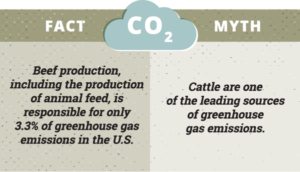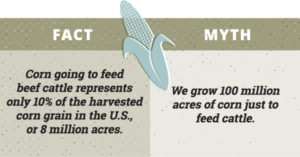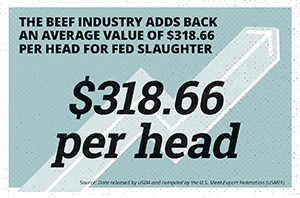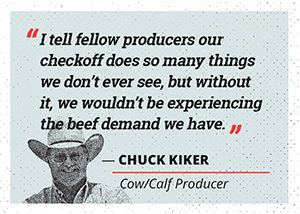According to “Environmental Footprints of Beef Cattle Production”1 a study recently published in the journal Agricultural Systems, widely accepted claims about beef cattle’s environmental impact in the U.S. are often overestimated.
The lifecycle assessment, conducted by the USDA’s Agricultural Research Service and the Beef Checkoff, was designed to scientifically quantify the sustainability of U.S. beef production. Researchers collected and examined feed- and cattle-production-related data from more than 2,200 cattle producers in seven regional production areas. They derived their conclusions by using a simulation model and regional production data to estimate national impacts on greenhouse gas emissions, fossil energy use, blue water consumption and reactive nitrogen loss.
While these conclusions are compelling, a recent EAT-Lancet 50-page suggests that the only way to save the planet is to eat less meat, eat more nuts and beans, or adopt a “flexitarian” diet (defined as flexible vegetarianism, eating more vegetables than meat). Frank Mitloehner, Ph.D., professor and air quality specialist for the Department of Animal Science at the University of California – Mitloehner, says in order to meet EAT-Lancet’s solution of replacing meat with nuts, the U.S. would have to increase nut production by 580 percent.
“What we need are more nutrient-rich foods like beef and eggs,” Dr. Mitloehner explains.
As others try to influence dietary guidelines throughout the world, Dr. Mitloehner cautioned that the often-cited data in the 2006 FAO report (Livestock’s Long Shadow) and other soon-to-follow reports will continue to make inaccurate claims about food production.
“The way you produce animals has a profound impact on environmental footprint,” Dr. Mitloehner says. “Although these reports are full of inaccuracies, don’t just disregard them as they will impact us for a long time. Check them for credibility and respond in a meaningful way.”
The fact is that beef production, including the production of animal feed, is responsible for only 3.3 percent of greenhouse gas emissions in the U.S. This is dramatically lower than the often-misquoted global livestock figure of 14.5 percent2.
Dr. Mitloehner goes on to explain that global numbers have intentionally distorted the sustainability picture. Truth be told? By continuously improving their production practices, today, U.S. beef farmers and ranchers are able to produce the same amount of beef with one-third-fewer cattle than they did in 1977.
This is exactly why the checkoff conducted the lifecycle assessment – to give consumers and the industry the real story of beef sustainability – something everyone can read and believe.
“This lifecycle assessment delivers the most comprehensive and accurate assessment of the environmental impact of beef cattle in the U.S. to date,” says USDA researcher and study co-author Alan Rotz.
This information was distributed via the wire to consumer-directed media outlets, and it is also currently featured on the “Beef in a Healthy, Sustainable Diet” page on BeefItsWhatsForDinner.com. For more information about beef production practices and sustainability, visit BeefItsWhatsForDinner.com.
Beef Sustainability: Fact vs. Myth

Source [1]

Source [1]

Source [1]

Source [1]



 The theme of the Times Square promotion was “Your Sushi is getting Beefed Up!” Giant, colorful images of Beefshi and a link to
The theme of the Times Square promotion was “Your Sushi is getting Beefed Up!” Giant, colorful images of Beefshi and a link to 

 “Artificial Intelligence and its role in marketing are rapidly evolving every day, and the Beef Checkoff is on the cutting edge by investing in this technology to constantly meet changing consumer expectations,” said Season Solorio, Senior Executive Director, Brand Marketing & Communications, National Cattlemen’s Beef Association, a contractor to the Beef Checkoff, who manages the “Beef. It’s What’s For Dinner.” brand. “In March we will turn things up a notch with an exciting campaign that will be an integrated effort, including digital advertising, media relations, influencer engagement and supply chain activities, to bring more widespread awareness to Chuck.”
“Artificial Intelligence and its role in marketing are rapidly evolving every day, and the Beef Checkoff is on the cutting edge by investing in this technology to constantly meet changing consumer expectations,” said Season Solorio, Senior Executive Director, Brand Marketing & Communications, National Cattlemen’s Beef Association, a contractor to the Beef Checkoff, who manages the “Beef. It’s What’s For Dinner.” brand. “In March we will turn things up a notch with an exciting campaign that will be an integrated effort, including digital advertising, media relations, influencer engagement and supply chain activities, to bring more widespread awareness to Chuck.”






 The CBB’s new chair, Chuck Coffey, is a fifth-generation rancher who grew up on a ranch in the hill country of Harper, Texas. He earned his bachelor’s and master’s degrees in range science from Texas A & M. After completing his master’s degree in 1985, Coffey taught agriculture at Murray State College in Tishomingo, Oklahoma, eventually chairing the department until 1993 when he joined the Noble Foundation as a pasture and range consultant. Today, Coffey and his wife operate a cow-calf operation with approximately 1,000 head of cattle near Springer, Oklahoma.
The CBB’s new chair, Chuck Coffey, is a fifth-generation rancher who grew up on a ranch in the hill country of Harper, Texas. He earned his bachelor’s and master’s degrees in range science from Texas A & M. After completing his master’s degree in 1985, Coffey taught agriculture at Murray State College in Tishomingo, Oklahoma, eventually chairing the department until 1993 when he joined the Noble Foundation as a pasture and range consultant. Today, Coffey and his wife operate a cow-calf operation with approximately 1,000 head of cattle near Springer, Oklahoma. Vice chair Jared Brackett is a fifth-generation cow-calf producer from Filer, Idaho. Brackett is a Texas A & M alum and die-hard Aggie fan with a degree in agriculture economics. A past president of the Idaho Cattlemen’s Association, Brackett continues to serve on a number of other livestock committees and boards in addition to his responsibilities with the Beef Checkoff program.
Vice chair Jared Brackett is a fifth-generation cow-calf producer from Filer, Idaho. Brackett is a Texas A & M alum and die-hard Aggie fan with a degree in agriculture economics. A past president of the Idaho Cattlemen’s Association, Brackett continues to serve on a number of other livestock committees and boards in addition to his responsibilities with the Beef Checkoff program.

 In fiscal year 2018, the Beef Checkoff program invested checkoff funds of $7.36 million in foreign marketing and education because exports represent a significant growth opportunity for U.S. beef producers. By selling U.S. beef in more than 80 countries worldwide, the beef industry adds back an average value of $318.66 per head for fed slaughter to U.S. beef producers, according to data released by United States Department of Agriculture (USDA) and compiled by the U.S. Meat Export Federation (USMEF). USDA research also showed, from January through August 2018, beef export value climbed 18 percent from a year ago to $5.51 billion.
In fiscal year 2018, the Beef Checkoff program invested checkoff funds of $7.36 million in foreign marketing and education because exports represent a significant growth opportunity for U.S. beef producers. By selling U.S. beef in more than 80 countries worldwide, the beef industry adds back an average value of $318.66 per head for fed slaughter to U.S. beef producers, according to data released by United States Department of Agriculture (USDA) and compiled by the U.S. Meat Export Federation (USMEF). USDA research also showed, from January through August 2018, beef export value climbed 18 percent from a year ago to $5.51 billion. As the old saying goes, “knowledge is power.” It is difficult to advocate for any organization unless you truly understand it. We recently sat down with Chuck Kiker, a cow/calf producer from Beaumont, Texas, to learn more about his first encounter with the Beef Checkoff and his journey from knowing little about the program to understanding and fully supporting it.
As the old saying goes, “knowledge is power.” It is difficult to advocate for any organization unless you truly understand it. We recently sat down with Chuck Kiker, a cow/calf producer from Beaumont, Texas, to learn more about his first encounter with the Beef Checkoff and his journey from knowing little about the program to understanding and fully supporting it.


 When asked about checkoff activities, two out of three producers said “informing producers about the results of beef checkoff programs” was essential. The Cattlemen’s Beef Board invests a small percentage (about 3.5 percent) of its total budget to keep all producers informed about what their money is accomplishing. This year, funding will be spent on an initiative called
When asked about checkoff activities, two out of three producers said “informing producers about the results of beef checkoff programs” was essential. The Cattlemen’s Beef Board invests a small percentage (about 3.5 percent) of its total budget to keep all producers informed about what their money is accomplishing. This year, funding will be spent on an initiative called  We all know that our industry continues to face challenges from various action groups.
We all know that our industry continues to face challenges from various action groups. 